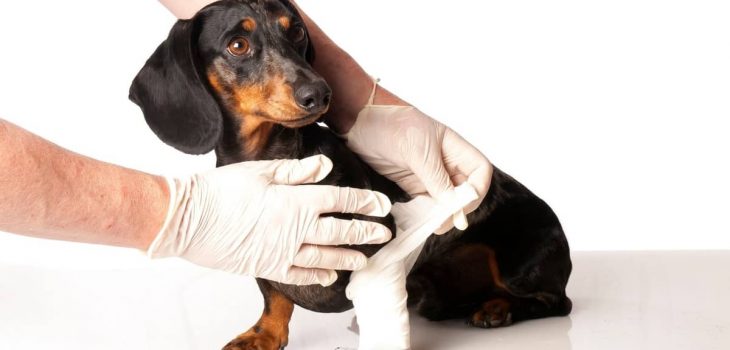Most people are aware that dachshunds have some spinal issues. However, there are other things to watch out for with this breed. So, let’s go over the common dachshund front leg problems and what to do about them. We’ll cover the several main types of Doxie leg issues, how common they are, what their symptoms are, and what you can do about them.
5 Most Common Dachshund Front Leg Problems
Because of their long backs, dachshunds often have back problems. This is largely due to the genetic dwarfism that the breed was selected for. Another feature of this dwarfism is the Doxies’ short legs. And, as with their back, the unique shape of the Doxies’ legs also leads to some possible health problems.
The front legs of dachshunds are especially problematic but their back legs are not devoid of issues either. Here are the 5 main conditions to watch out for:
1. Antebrachial Growth Deformity
This condition is specific to the front legs of dachshunds and if affects their length. Simply put, Doxie with an Antebrachial growth deformity will have one leg being shorter than the other.
In and of itself, this isn’t life-threatening, however, it easily leads to other serious conditions. Because a dog with an Antebrachial growth deformity will have an uneven posture, this can lead to both joint and back problems, as well as quite a bit of pain and discomfort. Surgical intervention is often necessary or at least strongly recommended.
2. Bowlegged Syndrome
This syndrome, also called pes varus, affects the hind legs rather than the front legs. It is pretty common in dachshunds, however, and is worth a mention. As the name implies, pes varus leads to the legs of the dachshund having a curved bow-like shape. This is typically because the distal tibia bone gets turned inwards.
As with antebrachial grown deformity, the bowlegged syndrome can lead to both pain and other problems due to the improper walking pattern.
3. Luxating Patella
Luxating Patella or Patellar Luxation is another condition that often strikes the dachshund’s hind legs. It’s a problem that hits the Doxies’ knees and is basically a misaligned or displaced kneecap.
Initially, the condition starts with the kneecap periodically sliding in and out of place. Over time, the condition tends to worsen and dislocations become more and more common. This makes the dachshund’s movement more challenging and painful. More importantly, it means that the other joints in the legs get more stress, leading to traumas and arthritis.
4. Elbow Dysplasia
Similar to hip dysplasia in other breeds, elbow dysplasia affects the elbow joints of the Doxie. Deformation in these joints affects the three main bones in the dog’s legs and easily leads to more bone deformation. Medication can help in the more mild cases and/or when you catch the condition early. However, more often than not, a surgical intervention will be necessary.
5. Traumas and Injuries
Dog front leg injury problems are not uncommon for dachshunds. Any dog can accidentally hurt its legs when running around, but when the dog’s back is abnormally long and its legs – a little impractically short – accidents become more likely.
This is especially the case if you’re trying to get your dachshund to lose weight with extra daily exercise. This is, of course, good, but dachshunds’ exercise regimes need to be extensive but not overly straining.
Another common cause of accidents is homes that force the dog into too many jumps. For example, if there’s a staircase in your home, you might want to add a little ramp on the side for your dachshund. Or, if the dog loves jumping on and off the couch or the bed, building small ramps can relieve the stress on the front legs.
What Are The Main Signs Of Dachshund Leg Problems?
Dachshund’s front leg problems can be noticed pretty easily in their advanced stages. Unfortunately, by that point, it’s usually too late to avoid the need for surgical intervention.
If you want to be able to treat your Doxie’s potential future health issues with just medications, you need to keep an eye for the earliest possible symptoms. Obviously, routine et check-ups are also crucial for a breed like the dachshund. Here are the main symptoms to watch out for:
- Dachshund front leg limp
- The position of the legs
- Different leg lengths
- Shorter steps
- Stiffness
- The Doxie is not as playful as usual
- The dog refuses/avoids to run
- Fewer jumps up and down the furniture or the stairs
- A bad mood
- Lack of appetite
- Irritability
- Whining, especially when moving or during the night
Are Shaking, Inability To Walk, and Partial/Full Paralysis Symptoms Of Leg Problems?
These are issues that distressingly many dachshund owners have to deal with at one point or another. However, these are not symptoms of leg problems. Instead, they are symptoms of back problems – usually Intervertebral Disc Disease (IVDD).
If your dog has shaking, paralysis, or walking difficulties in its front legs, the spinal issues are likely near the base of the neck. On the other hand, if the symptoms are prominent in the hind legs, the problems are likely in the lower back.
Whatever the case, however, it should be obvious that you need to contact your vet immediately.
Find more information about Dachshund Shaking And Lethargic Mood – 18 Possible Causes
How Are The Common Dachshund Front Leg Problems Treated?
Almost all of the issues above will need to be treated surgically, especially if they are left unchecked for too long. Some, like elbow dysplasia, can be treated with medications but only if you catch them early.
Whatever the issue, you will need to follow your vet’s instructions to the letter. Ideally, your dog will just avoid most or all of these problems. To achieve that, make sure that:
- You’re feeding your Doxie with a high-quality diet
- You give your regular, extensive, and measured exercise
- Give your dog a safe and comfortable lifestyle that doesn’t stress its back and legs too much
- Don’t skip on the regular vet visits – ideally twice a year even if there aren’t any noticeable problems at the time

Do that and – with a bit of luck – your Doxie should avoid all the above issues pretty comfortably.
Read more about: Dachshund Hind Leg Problems




